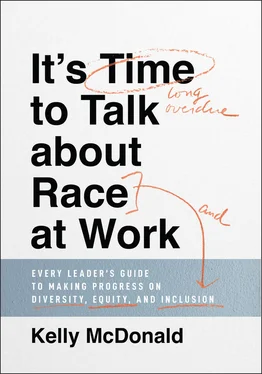WHY BIAS MATTERS IN BUSINESS
Right now, especially if you're White, you may be thinking, “OK, if bias just means preference, not hate or prejudice, why is it such a big deal in business? Our company doesn't discriminate against anyone.” It's a legitimate question. Businesses are not focused on overcoming bias because of a “Kumbaya/We Are the World” mindset. I'm betting that your company, your team, and you, yourself, truly believe in, support, and value diverse perspectives, and that's terrific. But despite that, you can still have blind spots that come from your biases, and those blind spots will hinder your success and progress as an organization. Blind spots can be tricky because you don't even know they're there. In business, they can be deadly. They can lead to poor morale, employee defection, lost customers, lower sales and profits, lack of innovation, and poor decision-making. And worst of all: You won't know about the negative impact of your blind spots until after something has happened. That should send chills down your spine!
Let me give you an example that will illustrate why business bias can be harmful to your organization's performance. Let's say an executive on your team is White and must hire someone for an open position. The White executive interviews two candidates who are equally qualified ; one is White, and one is Black. The executive hires the White person. The hiring executive doesn't think, “I didn't hire that other person because she is Black,” but rather, “I hired this person because I like her better—and the person I like better just happens to be White.” That thought is, of course, happening at an unconscious level, which is why, in business, this is referred to as unconscious bias or implicit bias . Unconscious bias can lead to hiring more people who are just like all your other team members. It can lead to hiring the wrong person, simply because you “prefer” them, or to promoting someone who is not ready for a higher-level position.
Another potential harmful effect of unconscious bias in business is that we are more likely to side with people we prefer or like in disagreements or in decision-making. So our biases have repercussions in terms of whom we tend to favor or agree with. Again, all of this is happening at an unconscious level. We aren't aware of it when it's happening.
JUSTIFYING YOUR DECISIONS AND ACTIONS
Our brains like logic. They like it when we make sensible, logical decisions. They like it so much that they rationalize our decisions— after the fact—to justify the choices we make. It's called post-hoc justification .
Here's an example of how post-hoc justification works. A study by Yale researchers 1 found that people making hiring decisions actually shifted the job criteria to fit the candidate they wanted to hire. In the study, participants were asked to hire a new police chief for a hypothetical police department. They evaluated separate applications from a male (Michael) and female (Michelle) applicant. The male applicant was presented as having more street smarts, and the female applicant was presented as having more formal education. The hiring evaluators' subconscious impression of the female applicant was negative, but they found logical reasons for justifying that impression after they made their decision to hire the male applicant (post-hoc).
The study found that evaluators decided that “street smarts” were the most important trait for the position of police chief when they decided to hire the male applicant. However, when the names were reversed on the résumés in the hypothetical example and “formal education” was listed as the male applicant's strength, evaluators decided that “formal education” was the most important trait for the position, and that was the reason given for hiring the male applicant. The conclusion of the study was that people construct the criteria of merit to fit their biases as they make hiring decisions. And they will change the criteria to fit the decision that is ultimately made. That's weird. And certainly biased. You can see how unconscious bias leads to a decision and then post-hoc justification kicks in to validate the choice made.
So now you may be thinking, “We would probably never fall prey to that. Our company is pretty objective about hiring and key decision-making.” Well, perhaps.
But consider this: The same study by Yale researchers found that perceiving yourself as objective is actually correlated with showing more bias. Participants who felt most strongly that they were objective proved to be the most biased. So weird! But that's exactly the kind of blind spot that bias can create.
To cut to the chase, the study's conclusion is that our mere desire to see ourselves as unbiased is not enough to overcome decades of cultural conditioning. That desire can lead to even more post-hoc justifications. We want to think of ourselves as unbiased, so we do think of ourselves that way. But that doesn't mean we are.
Most people are good people. Acknowledging that you have biases that conflict with your values does not make you a bad person. It makes you normal . It's a natural result of our culture and our very basic survival trait as human beings. Remember, even babies are biased! The important thing is to find ways to get around those biases and eliminate them wherever you can. Blindly believing that your company or your team is a meritocracy, where everyone is evaluated solely on merit, does not make it so . In fact, it'll make it that much harder to address implicit bias because no one will admit it's there in the first place.
The best companies and leaders are not afraid to admit that unconscious bias exists within their ranks. In fact, they search for and identify the biases and blind spots so they can address and correct them.
1 1Eric Luis Uhlmann and Geoffrey L. Cohen, “Constructed Criteria—Redefining Merit to Justify Discrimination,” Psychological Science 16, no. 6 (2005): pp. 474–480.
CHAPTER 3 The High Cost of Bias: Why All-White or Mostly White Businesses Make Less Money
If your business or team is all-White, or mostly White, you may not think that's a problem, especially if you're successful and profitable. If business is good, it's easy to keep doing what you've been doing and not question whether there is a need to change your strategies and tactics. Why would you? You're successful and making money! Why would you change a thing?
But despite your success, you may be missing out on something. And you may not be able to see what you're missing because you and your team are pretty much the same and have only “one lens”—the way that you and your team view the business world is likely very similar. You don't have other perspectives or views that might challenge your thinking, create better solutions, or offer new ideas.
Here is an example of how a lack of different perspectives can cost you. Downhill skiing is a big deal. It's a multi-billion-dollar industry and employs thousands of workers. From the equipment manufacturers and retailers to the resorts and instructors, skiing is big business. Or it was, until the 1990s. In the 1990s, the ski industry started seeing an alarming trend: fewer skiers overall, fewer ski trips booked, fewer ski passes sold, and stagnant equipment and gear sales because skiers themselves were spending less time on the slopes. Why was this happening? Two big demographic issues were responsible:
1 The skiers themselves were aging. The core ski enthusiasts were getting older and that meant increased aches and pains and risk of injury. If you're 65 years old and just had a knee replacement, skiing probably isn't a sport that's high on your list.
Читать дальше












